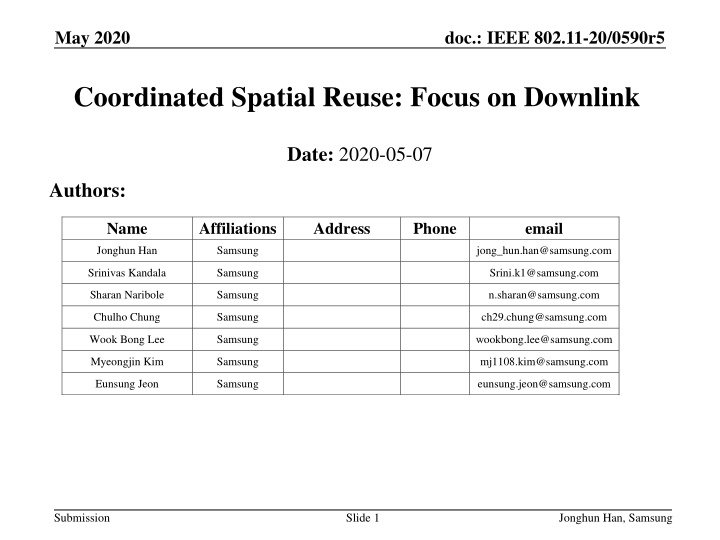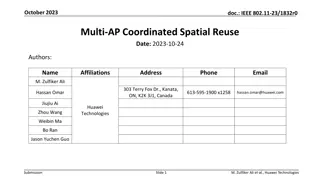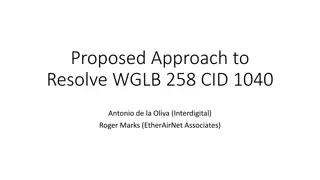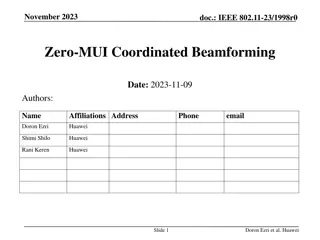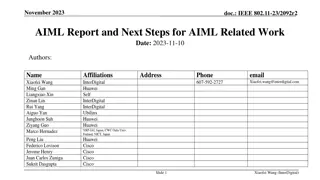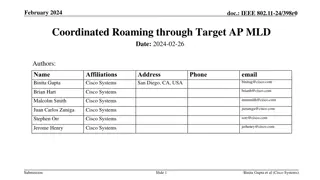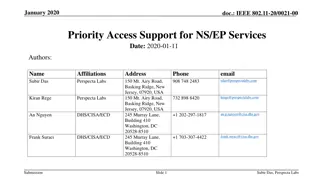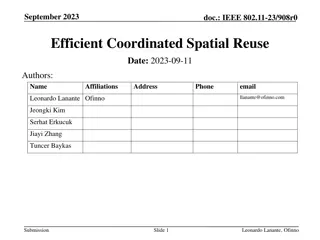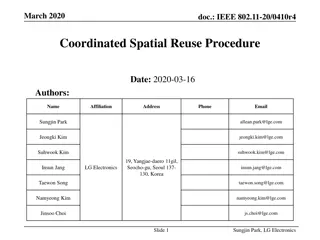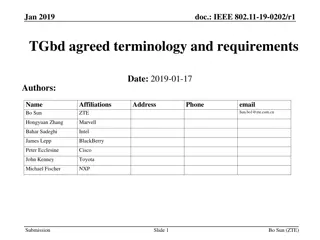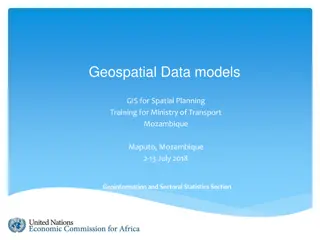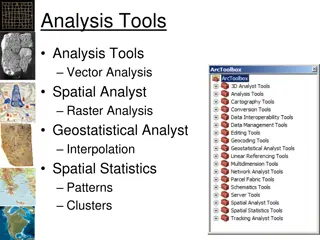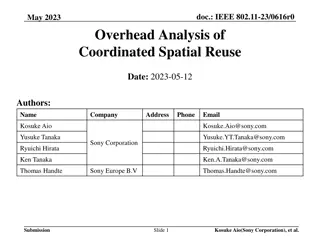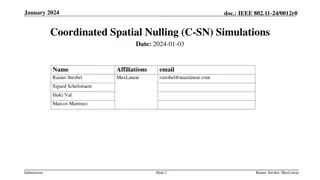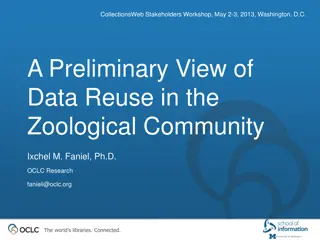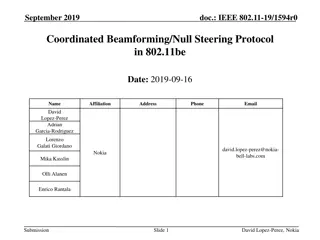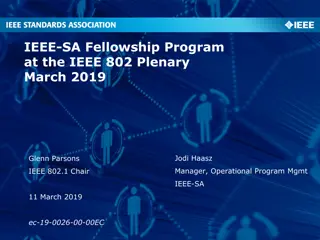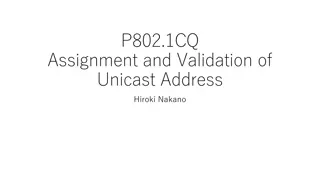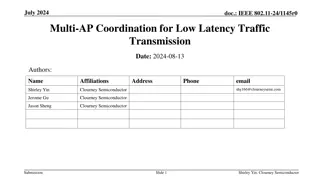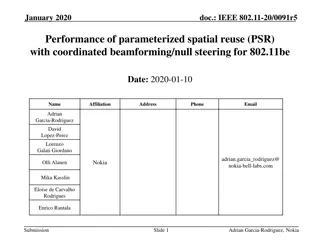Coordinated Spatial Reuse in IEEE 802.11 Networks
The document discusses Coordinated Spatial Reuse (C-SR) in IEEE 802.11 networks, focusing on downlink transmission. C-SR is a multi-AP coordination scheme aimed at enhancing spectrum efficiency by reusing time/frequency resources among multiple Basic Service Sets (BSSs). The procedure is divided into three phases: preparation, coordination policy, and execution, with considerations for AP issues and performance gains compared to other schemes. Various coordination policies are explored, such as bi-directional and one-way approaches, each offering benefits in throughput, signaling overhead, and power management.
Download Presentation

Please find below an Image/Link to download the presentation.
The content on the website is provided AS IS for your information and personal use only. It may not be sold, licensed, or shared on other websites without obtaining consent from the author.If you encounter any issues during the download, it is possible that the publisher has removed the file from their server.
You are allowed to download the files provided on this website for personal or commercial use, subject to the condition that they are used lawfully. All files are the property of their respective owners.
The content on the website is provided AS IS for your information and personal use only. It may not be sold, licensed, or shared on other websites without obtaining consent from the author.
E N D
Presentation Transcript
May 2020 doc.: IEEE 802.11-20/0590r5 Coordinated Spatial Reuse: Focus on Downlink Date: 2020-05-07 Authors: Name Affiliations Address Phone email Jonghun Han Samsung jong_hun.han@samsung.com Srinivas Kandala Samsung Srini.k1@samsung.com Sharan Naribole Samsung n.sharan@samsung.com Chulho Chung Samsung ch29.chung@samsung.com Wook Bong Lee Samsung wookbong.lee@samsung.com Myeongjin Kim Samsung mj1108.kim@samsung.com Eunsung Jeon Samsung eunsung.jeon@samsung.com Submission Slide 1 Jonghun Han, Samsung
May 2020 doc.: IEEE 802.11-20/0590r5 Recap: Coordinated SR (C-SR) C-SR is a simple Multi-AP coordination scheme that can increase spectrum efficiency by reusing the same time/frequency resources among multiple BSSs C-SR procedure C-SR procedure with unsolicited method [1] General C-SR procedure [2] C-SR performance gain Compared to OBSS-PD and TDD [3] Compared to EDCA and complete control [4] Compared to C-OFDMA and OBSS-PD [5] In this contribution, we divide the downlink (DL) C-SR procedure into 3 phases and investigate several issues of C-SR operation Slide 2 Submission Jonghun Han, Samsung
May 2020 doc.: IEEE 802.11-20/0590r5 AP Issue 1: C-SR Coordination Policy STA [Option 1] DL TX C-SR gain comes from appropriate Tx power management Sharing AP Option 1: bi-directional coordination Sharing AP and shared AP negotiate the appropriate Tx power combination Could be better in terms of sum throughput Additional signaling overhead Shared AP Negotiated power Negotiated power Option 2: one-way coordination (Preferred) Sharing AP determines Tx power without a coordination process and limits the Tx power of shared AP to protect transmissions of sharing AP Sharing AP does not need to sacrifice its performance Less overhead Enough power Sharing AP Shared AP Less power [Option 2] Submission Slide 3 Jonghun Han, Samsung
May 2020 doc.: IEEE 802.11-20/0590r5 C-SR Procedure into 3 Phases Preparation phase: before AP obtains TXOP 1. 1 3 ??? ??? AP ??? ????? STA AP1 AP2 Signal ??? ??? ??? 2 4 AP s action list Decide a AP candidate set Collect capability (of AP2 in AP1 s point of view) Collect Rx RSSI information of neighboring C-SR capable APs and calculates path loss (????2in AP1 s point of view) Collect Rx RSSI information from associated STAs Collect associated STA s Rx RSSI from the associated AP and calculates path losses (??1,??2in AP1 s point of view) Collect associated STA s Rx RSSI from neighboring C-SR capable APs and caculates path losses (??1 ??2,??2 ??2in AP1 s point of view) AP s role in C-SR transmission is not determined yet Submission Slide 4 Jonghun Han, Samsung
May 2020 doc.: IEEE 802.11-20/0590r5 C-SR Procedure into 3 Phases Announcement phase: after AP obtains TXOP If the AP is willing to share the obtained TXOP, it becomes a sharing AP Sharing AP s action list Select the shared AP from the AP candidate set Considering DL STA s SINR of sharing AP Trigger the shared AP s transmission using announcement frame Essential information: AP ID, Tx power limit Transmission phase: after the potential shared AP obtains the shared TXOP If an AP receives the announcement frame successfully and is willing to participate in the C-SR transmission, the AP becomes a shared AP Shared AP s action list Set Tx power based on the guide obtained from the announcement frame C-SR transmissions (including block acknowledgement) of the sharing/shared APs occur simultaneously in the shared TXOP Assumption: start/end time of C-SR transmissions are aligned 2. 3. Submission Slide 5 Jonghun Han, Samsung
May 2020 doc.: IEEE 802.11-20/0590r5 Issue 2: Obtaining/Delivering Path Loss AP who is willing to share its TXOP requires Path loss with neighboring C-SR capable AP Can obtain from a measurement Path loss with associated STA Can obtain from a report Path loss between associated STA and neighboring C-SR capable AP Can obtain from a report How to calculate path loss? STA can use beacon as a reference of path loss estimation (Beacon Tx power) (Beacon Rx signal strength) We need an element or a field which indicates beacon Tx power information. C-SR capable AP can include the element or the field in the beacon frame. Submission Slide 6 Jonghun Han, Samsung
May 2020 doc.: IEEE 802.11-20/0590r5 Issue 2: Obtaining/Delivering Path Loss Path loss report from STA AP can solicit path loss reports of its associated STA Path loss with the associated AP Path loss with the neighboring C-SR capable AP STA can estimate the path loss from the received beacon signal and is able to report path loss according to the request from the AP We need a signaling procedure for the path loss report from STA. We can reuse Measurement Request/Report 1 2 ??? ??? Path loss obtained by AP1 From request/report: ??1 and ??1 ??2 From measurement: ????2 ??? ????? AP1 AP2 Submission Jonghun Han, Samsung Slide 7
May 2020 doc.: IEEE 802.11-20/0590r5 Issue 2: Obtaining/Delivering Path Loss TPC report element format defined in baseline specification TPC report procedure Solicited TPC request frame and TPC response frame (action frames) Unsolicited A TPC report element is included in Beacon or Probe response frame without a corresponding request C-SR supporting AP will use this element to indicate its beacon transmission power Slide 8 Submission Jonghun Han, Samsung
May 2020 doc.: IEEE 802.11-20/0590r5 C-SR Procedure Example: 2-BSS DL/DL AP2 obtains the shared TXOP shared AP AP1 obtains TXOP sharing AP Collecting Capability/Path loss C-SR-A DL MU AP1 BA STA1-1 BA STA1-2 DL MU AP2 Measuring and Collecting Path loss Report BA STA2-1 BA STA2-2 Announcement Phase Preparation Phase Transmission Phase Measurement Report * C-SR-A: C-SR announcement frame Submission Slide 9 Jonghun Han, Samsung
May 2020 doc.: IEEE 802.11-20/0590r5 Issue 3: Block Acknowledgement (BA) Separation Problem BA transmissions of STAs simultaneously occur in the shared TXOP Tx power limit applies to shared AP s transmission Solution Separation of BA transmissions of the STAs associated with sharing/shared AP Options for BA separation [Option 1] Non-overlapping resources for BA (preferred) Allocate non-overlapping frequency resources for BAs of sharing/shared AP Non-overlapping frequency resource allocation for BA is determined by the sharing AP and included in the announcement frame [Option 2] Implicit BA for sharing AP side, and delayed BA for shared AP side Pros: simple Cons: overhead Submission Slide 10 Jonghun Han, Samsung
May 2020 doc.: IEEE 802.11-20/0590r5 Issue 3: Block Acknowledgement (BA) Separation [Option 1] Non-overlapping resources for BA in detail Two-level BA separation Level 1: BA separation among sharing/shared APs E.g. upper 40MHz for sharing AP, lower 40MHz for shared AP Level 2: BA separation between DL STAs in each BSS (DL MU PPDU case) STAs send the immediate response according to the resource allocation information that is carried in the TRS control subfield frequency BA of STA1 3 C-SR Transmission of sharing AP (DL MU PPDU) BA of STA2 40MHz Shared AP SIFS 1 same 40MHz time frequency 4 Sharing AP C-SR Transmission of shared AP (DL MU PPDU) 2 40MHz BA of STA3 BA of STA4 time Submission Slide 11 Jonghun Han, Samsung
May 2020 doc.: IEEE 802.11-20/0590r5 Summary We divide C-SR procedure into 3 phases according to TXOP acquisition status of sharing/shared AP We believe that one-way coordination is an appropriate policy to manage the Tx power of sharing/shared AP in C-SR operation To determine the maximum Tx power of shared AP, sharing AP collects path loss information from the associated STAs and neighboring C-SR capable APs by soliciting reports We propose two options for BA separation Submission Slide 12 Jonghun Han, Samsung
May 2020 doc.: IEEE 802.11-20/0590r5 Straw Poll #1 Do you agree that in 11be sharing AP limits the shared AP(s) transmission power during the shared TXOP in C-SR procedure? Sharing AP may reduce its transmission power in the shared TXOP Shared AP(s) shall follow the transmission power limit indicated by sharing AP in the shared TXOP Shared AP s transmission power limit is included in the announcement frame Shared AP s transmission power is limited by the information provided by the sharing AP and the information is included in the announcement frame NOTE: the term, shared TXOP, can be changed NOTE: the field indicating transmission power limit and its encoding are TBD Note: the exact format of the information in the announcement frame is TBD Submission Slide 13 Jonghun Han, Samsung
May 2020 doc.: IEEE 802.11-20/0590r5 Straw Poll #2 Do you agree that in 11be C-SR capable AP indicates its beacon transmission power in beacon frame? The beacon transmission power can be included in either one of element or field The element or field indicating the beacon transmission power and its encoding are TBD Note: C-SR capable AP may utilize TPC request/report element defined in the baseline spec Submission Slide 14 Jonghun Han, Samsung
May 2020 doc.: IEEE 802.11-20/0590r5 Straw Poll #3 Do you agree that in 11be the signaling for reporting path loss values is required? Signaling details are TBD NOTE: We may reuse Measurement request/response procedure defined in the baseline spec Submission Slide 15 Jonghun Han, Samsung
May 2020 doc.: IEEE 802.11-20/0590r5 Straw Poll #4 Do you agree that in 11be sharing AP allocates non-overlapping frequency resources of block acknowledgements for each sharing AP and shared AP(s) for C-SR operation? Allocating non-overlapping frequency resource shall be determined by sharing AP Minimum unit of frequency resource allocation is 20MHz The way of indicating non-overlapping frequency resources for block acknowledgement is TBD Submission Slide 16 Jonghun Han, Samsung
May 2020 doc.: IEEE 802.11-20/0590r5 Reference [1] 802.11-20/0410r4 Coordinated Spatial Reuse Procedure , Sungjin Park [2] 802.11-20/0576r1 Coordinated Spatial Reuse Protocol , Yongho Seok [3] 802.11-20/0457r1 Discussion on Coordinated Spatial Reuse Operation , Kosuke Aio [4] 802.11-20/0107r1 Multi-AP coordination for spatial reuse , Dmitry Akhmetov [5] 802.11-20/0073r0 On Coordinated Spatial Reuse in 11be , Jianhan Liu Submission Slide 17 Jonghun Han, Samsung
May 2020 doc.: IEEE 802.11-20/0590r5 APPENDIX Submission Slide 18 Jonghun Han, Samsung
May 2020 doc.: IEEE 802.11-20/0590r5 Calculation of Shared AP s Tx Power Limit 1 3 ??? ??? AP ??? ????? STA AP1 AP2 Signal ??? ??? ??? 2 4 Goal AP1 (sharing AP) wants to protect DL transmission for STA1 SIR of STA1, ???1= ???1 larger than ???? Procedure STA1 calculates ??1 from ???1 ??1= ???1 STA1 calculates ??1 ??2 from ???2 ??1 ??2= ???2 STA1 reports ??1 and ??1 ??2 to AP1 AP1 obtains ???2 ?? ??1 (???2 ?? ??1 ??2), should be ?? and ????1 ??1 ?? ??????1 ???1 ?? and ????1 ??2 ?? ????1 ??2 ??,???= ???1 ?? ??1 ??1 ??2 ???? Slide 19 Submission Jonghun Han, Samsung
May 2020 doc.: IEEE 802.11-20/0590r5 COMMENT RESOLUTION Submission Slide 20 Jonghun Han, Samsung
May 2020 doc.: IEEE 802.11-20/0590r5 Parameterized Spatial Reuse Objective AP uses a trigger frame to allow spatial reuse of OBSS STA(s) Operation AP indicates Acceptable Rx Interference Level in the trigger frame PSR-capable STA transmits with reduced power guided by the ARIL Slide 21 Submission Jonghun Han, Samsung
May 2020 doc.: IEEE 802.11-20/0590r5 Major Difference Between PSR and C-SR EDCA or Trigger-based Access? In PSR, TXOP owner allows EDCA-based access of random OBSS STA(s) In C-SR, TXOP owner (sharing AP) shares its TXOP with a designated shared AP. The shared AP is able to access the medium without EDCA. Sharing AP s shared TXOP Usage In PSR, TXOP owner always uses its TXOP for UL transmission. But in C-SR sharing AP is allowed to use DL transmission in the shared TXOP Allowing DL transmission of sharing AP requires additional path loss signaling compared to TXOP owner of PSR Sharing AP needs to consider DL STA s SIR. Path loss estimation/collection procedure In PSR, OBSS STA doesn t need additional signaling in terms of path loss STA utilizes Trigger frame for path loss estimation AP doesn t need to collect path loss C-SR requires additional signaling in terms of path loss STA utilizes Beacon frame for path loss estimation AP needs to collect path loss information to calculate the limitation of shared AP Submission Slide 22 Jonghun Han, Samsung
May 2020 doc.: IEEE 802.11-20/0590r5 Non-overlapping BA Necessity of non-overlapping BA Since we don t know the simultaneous reception of overlapping BA(s) at sharing/shared AP are successful or not, we should take a safe/conservative approach In a protocol design point of view, allowing multiple overlapping transmission without power/freq. management is not a desirable solution Preamble overlapping issue [Case1] BAs of sharing/shared STA are assigned to the RUs in the different 20MHz No preamble overlap between BAs of sharing/shared STA [Case2] BAs of sharing/shared STA are assigned to the RUs in the same 20MHz Sharing AP should assign different 20MHz BW for BAs of sharing/shared STAs Submission Slide 23 Jonghun Han, Samsung
May 2020 doc.: IEEE 802.11-20/0590r5 Etc. Transmission power indication in Beacon frame TPC report element is defined in the specification and can be used to indicate beacon transmission power (slide 8 added) Path loss signaling overhead Since path loss values are semi-static, once path loss collection is done, then AP can use collected path loss information for a while. Path loss collection is AP-side implementation issue C-SR considering UL I will cover it in the another contribution DCN 11-20/1040 Submission Slide 24 Jonghun Han, Samsung
